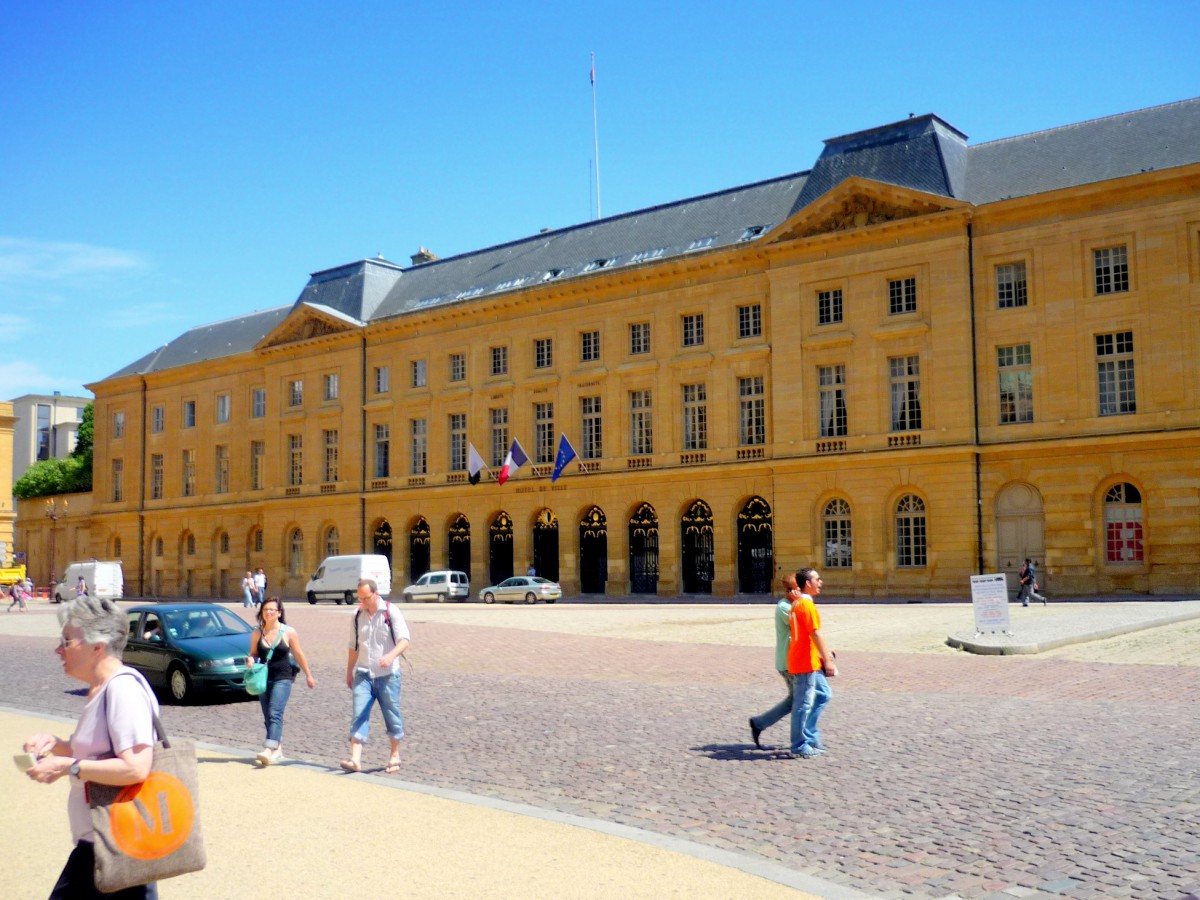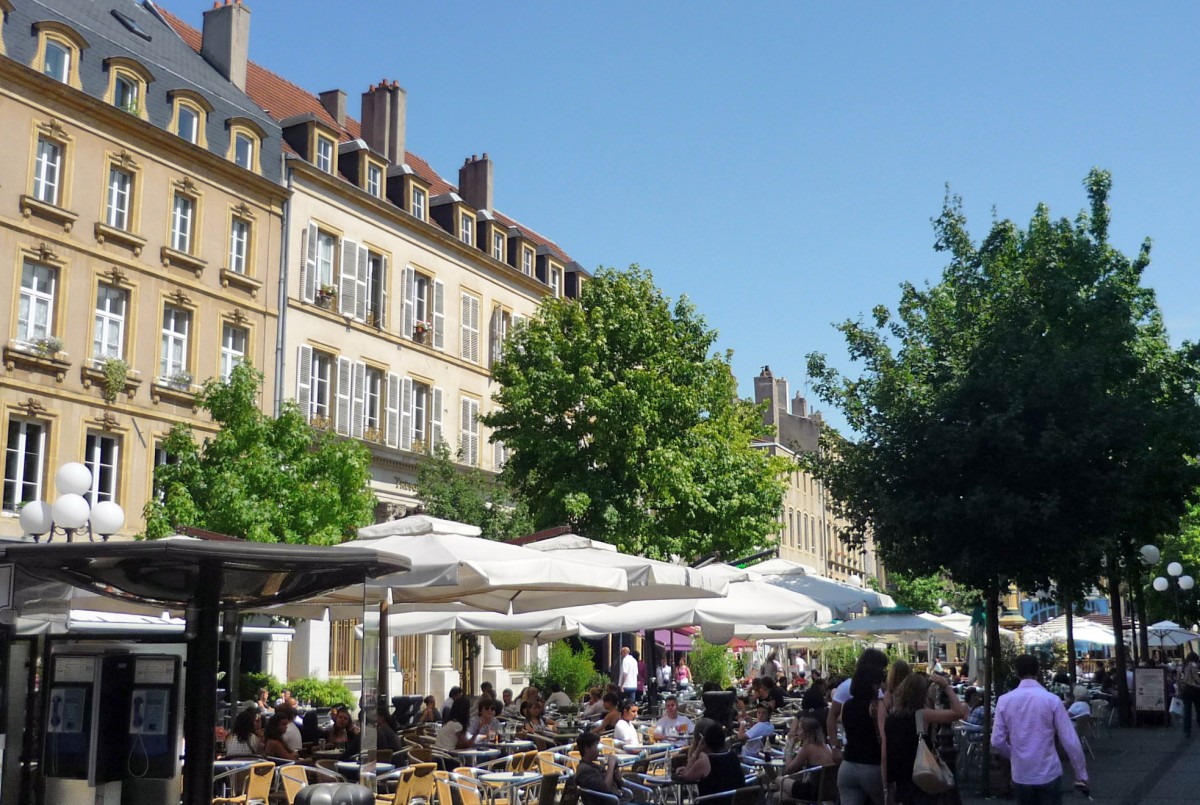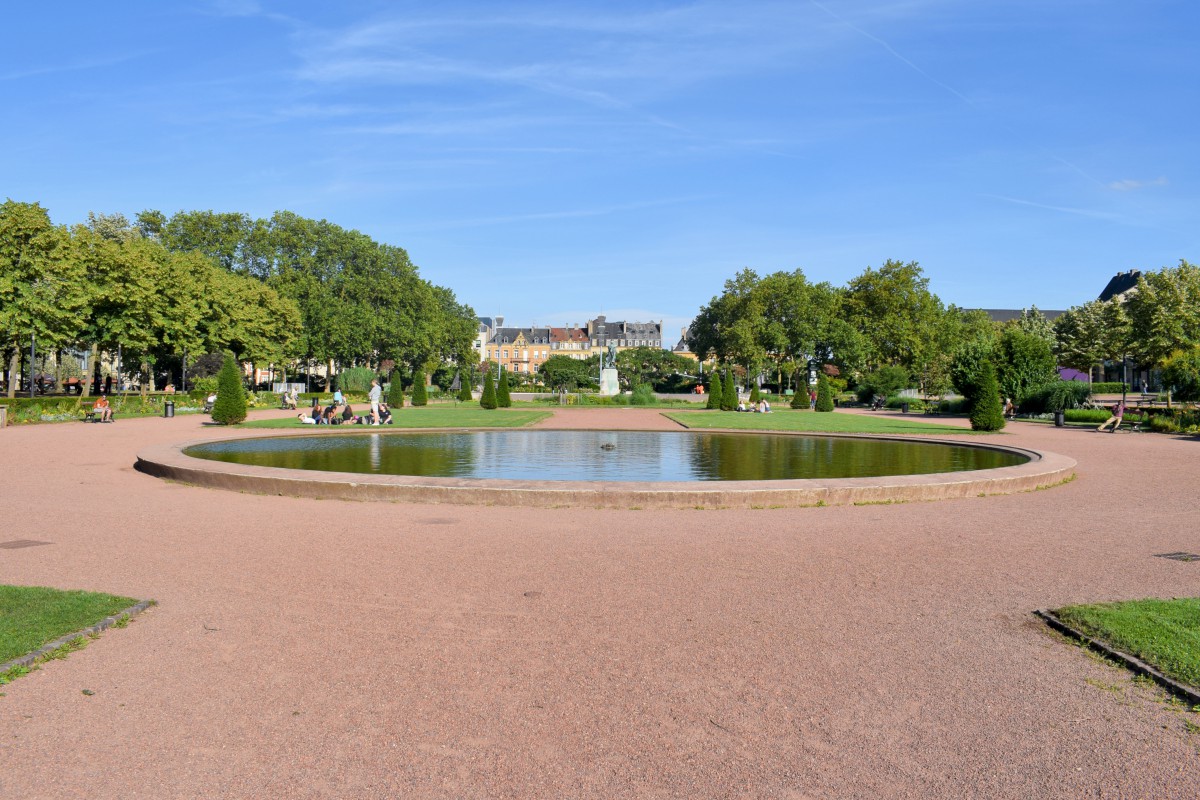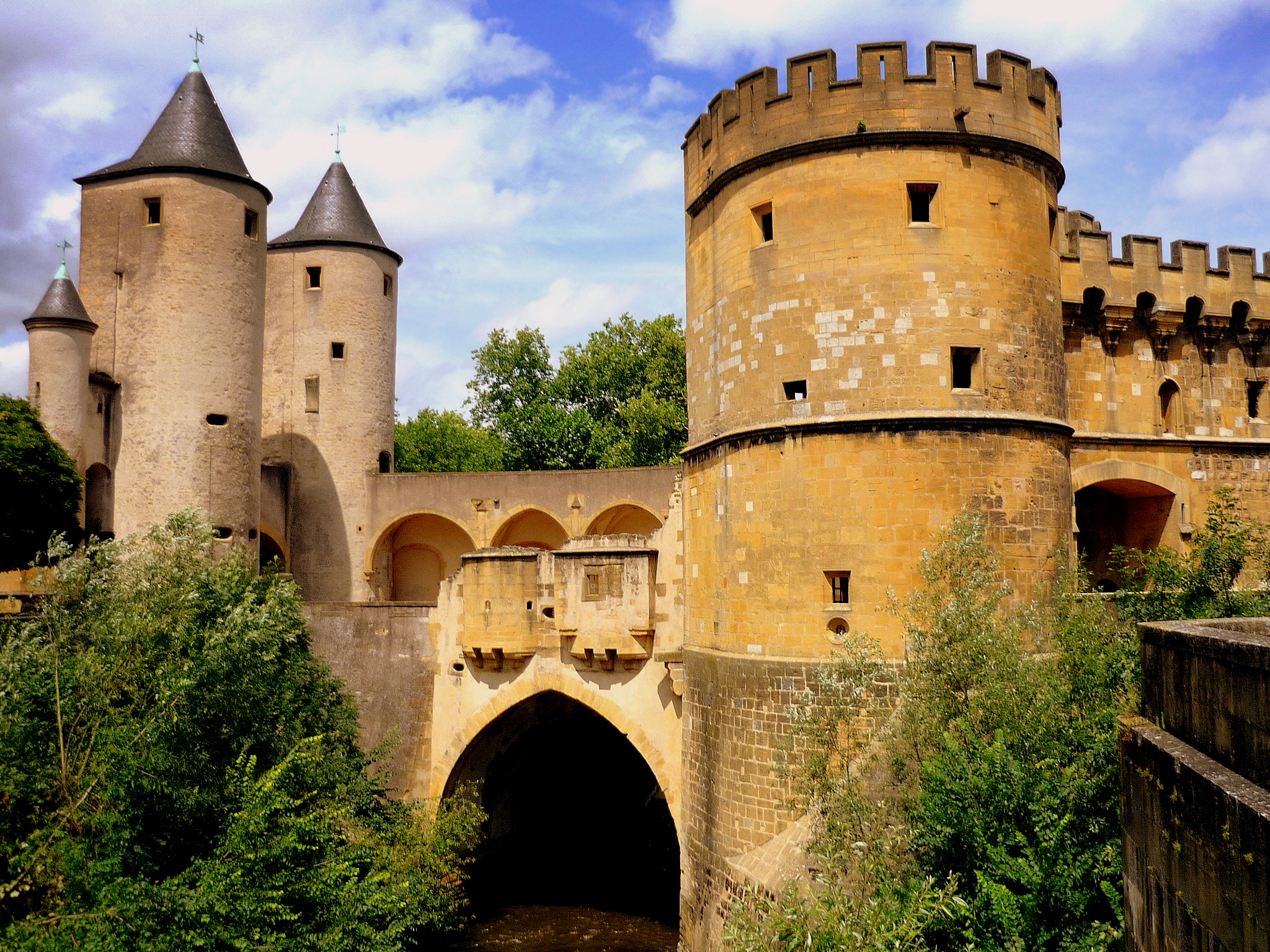Metz old town is famous for its lofty gothic cathedral and its German imperial district around the railway station. It takes pride in being a true Garden City, with its trees, flowerbeds and green esplanades. Today, no visitors to the peaceful city would believe how turbulent Metz’s history has been over the centuries, being continually annexed by France and Germany. Follow the guide to some of the town’s main sights.
Metz old town: main sights
The historic town of Metz includes not-to-be-missed sights such as:
- the Gothic cathedral St Etienne and place d’Armes
- the medieval place Saint-Louis
- the Germans’ Gate (porte des Allemands)
- the medieval Grenier de Chèvremont (Cour d’Or museum)
- the medieval-looking streets near the Récollets cloister
- the St-Pierre-aux-Nonnains church (one of France’s oldest Christian sanctuaries)
- the Templars’ chapel
- the German Imperial District around the railway station
The Gothic St. Stephen cathedral of Metz

Metz Cathedral stands out like the crown of the city. With its well-balanced proportions and its fine stained-glass windows, the lofty Cathedral is a masterpiece of Gothic architecture in France.
The nave of Saint-Etienne (41.41m) is the third-highest of any church in France after that of Amiens and Beauvais and the 10th in Europe, and it displays the largest surface of stained-glass windows (6,500 square metres).
Read more about Metz Cathedral.
The Place d’Armes

The cobbled place d’Armes is one of Metz old town’s beautiful squares. It is elegant and majestic as it is bordered by the Gothic cathedral on one side and the Town Hall on the other.
When planned in the 18th century, it was the centrepiece of the town planning commissioned by Marshall Belle-Isle and his successor the Marshall d’Estrées.
It followed the orders given by King Louis XV to create a square in Metz where all the powers (executive, legislative and judiciary) would be concentrated.
The Place d’Armes was created between 1750 and 1770 with the dismantlement of a church and a cloister adjacent to the Cathedral.
The buildings that border the square
The long building of the Town-Hall facing the Cathedral, a Parliament House and a Bishop’s Palace were expected to be built but were jeopardized partly because of the events of the French revolution.
The Pavilion closing the Northside of the square now houses the Metz Tourist Office. It was used as a guardhouse from where the soldiers could keep an eye on the busy activity occurring in the strategic square. It was useful to the architect as it completed the symmetry of the classical ensemble.
The military influence of the 18th century
Some maintain that the square was created in order to echo King Stanislas’ Place Stanislas in Nancy, which was then metamorphosing into the capital of the Dukes of Lorraine. Metz’ Place d’Armes is much soberer than its Nancy counterpart and reasserts the powerful influence of the 18th-century military over the city.
In 2007, the facades of the building on the square were cleaned and a new lighting system was installed. It would be a pity to leave Metz without admiring the square at night.
I particularly enjoy this square at Christmas when it houses a beautiful market and the tall Ferris Wheel.

The place St. Jacques

Place Saint-Jacques is situated at the heart of Metz old town near the Cathedral and the centre of the city centre’s shopping precinct.
It is well known by locals for its many cafés and restaurants whose terraces are popular in summer.
The square takes its name from a church (église Saint-Jacques) which used to stand here until it was dismantled in 1574.
The place de la Comédie

Another interesting square worth mentioning is Place de la Comédie. Located on the Ile du Petit Saulcy, it borders the Moselle River, just a stone’s throw from the Cathedral.
The square is bordered by the oldest working opera theatre in France, which was inaugurated in 1752 with a ball.
Until the French revolution, it staged plays of contemporary playwrights such as Racine, Corneille, Molière, Voltaire, Marivaux, Diderot, and Beaumarchais. But at the Revolution, the square was not really dedicated to fun and leisure as it became the setting for the guillotine, which cut some 63 heads. But once this dark era was gone, some renowned artists performed in Metz, such as Sarah Bernhardt in La Tosco in 1905.
To the right of the Opera Theatre stands the Temple Neuf, built during the German annexing of 1871-1918.
Around the Esplanade
Strolling down from the Cathedral towards the Esplanade, make sure you stop by the Moyen-Pont where the view of the Moselle River, the Temple-Neuf, and the Cathedral is delightful:

The Esplanade
The Esplanade was built on the site of a citadel and has now become a favourite urban park, with its flowered terrace, its peaceful fountains and the fine view over Mont Saint Quentin.

It is linked to the Place de la République (formerly known as “Place Royale”), designed in 1802. The whole space is being transformed into a vast pedestrianised area, thanks to a giant car park built underneath it.
From there you reach the church of Saint-Pierre aux Nonnains and a few metres further, the singular Knights Templar Chapel, which dates back to the 12th century.
Saint-Pierre-aux-Nonnains, the oldest church in France

Saint Pierre-aux-Nonnains, which is believed to be France’s oldest church, dates back to the 4th century.
Built between 380 and 395 AD as a Roman gymnasium, it was consecrated to the Christian faith in the 7th century.
Around 1000, Emperor Otto commissioned the building of a Romanesque nave.
Gothic vaults were added in the 15th and 16th centuries and eventually were destroyed during the great siege of Charles V in 1552.
From 1556, the new masters of Metz, the French, allocated the building for the army.
The former church became part of an arsenal and stayed as such until the 20th century. In the 1970s it was decided to renovate and transform the building into a concert and exhibition hall.
The Knights Templar Chapel

According to tradition, the Knights Templar who came to Metz in 1133 built the chapel between 1180 and 1220.
The church was part of a larger Commandry destroyed at the same time the Order was abolished.
It represents an architectural masterpiece in Lorraine as it is the only rotunda of that kind in the region.
Its circular layout is typical of the Templar tradition, (as in the cathedral of Aachen) and it is believed that the chapel was modelled after that of Laon, Picardy, and built 40 years earlier.
It was classified as a historic monument as early as 1840 at a time when the chapel was seriously in danger of being demolished by the building of the nearby citadel.
The outside of the chapel is still Romanesque architecture with its thick walls and its small arched windows.
However, inside, the architecture is moving towards early Gothic architecture with its vaults.
The sculpted keystone depicts the dove of the Holy Spirit and the walls are covered with mural paintings, which were heavily restored in 1905.
Note the distinctive ‘cross pattée’ of the Knights Templar which still decorates the lintel of the entrance door.
Today, the chapel is used as an exhibition hall.
The Porte Serpenoise

The Porte Serpenoise is a sort of triumphal arch which used to mark the South limit of the city of Metz from the 3rd until the early 20th centuries.
During the Roman era, the gate was guarding the road to Scarpone (now Dieulouard, near Nancy). In the 19th century, the gate was incorporated into the rampart, as a tunnel dug into the counterscarp.
When the German authorities decided to get rid of the walls, they kept the gate, which they redrafted into a triumphal arch, crowned with four bartizans taken from the destroyed ramparts.
On the gate have been placed inscriptions commemorating four major historical events linked to the city’s history:
- 1473: Metz was almost seized by the soldiers of the Duke of Lorraine, disguised as merchants. They managed to get through the Porte Serpenoise to Harelle the Baker who worked next to the gate and on that night sounded the alarm when he recognised them. The awakened city defeated the attack.
- 1552: German Emperor Charles V who was besieging Metz, could not take hold of the gate which was well defended by the Duke of Guise.
- 1870: on the 3rd of October, the Prussians entered Metz through the Porte Serpenoise, after the defeat of Napoleon III in Sedan.
- 1918: it was when the allied troops marched into Metz through it.
The Tour Camoufle

Many other witnesses of Metz’s medieval past can be seen whilst strolling in the Old Town.
One of the last examples is the “Tour Camoufle” (Camouflaged Tower), beautifully positioned at the centre of a public park on Avenue Foch, which was merged into the German Imperial District in the early 20th century.
A vestige of the medieval walls surrounding Metz, it was built around 1437 and carried the nickname of “Jacob de Castel”, a reputed artilleryman of the 15th century.
Until recently the tower was hidden behind a thick green setting, which suited the name of the tower best.
The German Imperial District of Metz

At the end of the Franco-Prussian War of 1870-71, Metz’s destiny changed dramatically as the city and its département (Moselle) were annexed by Bismarck to Germany.
Kaiser Wilhelm II personally oversaw the new town planning project around the railway station, to the South of the Old Town, in order to make Metz a model of German prestige and elegance.
This new but remarkable architectural example was commissioned by an architect from Berlin, Kröger, who erected many imposing buildings in the Rhenish tradition along Metz’s Grand Boulevards.
The “Pierre de Jaumont” which was traditional – and extensively – used so far everywhere was replaced with stones used in the Rhineland: pink and grey sandstone, granite and basalt.

Some large neo-Romanesque buildings typical of the German Empire successively appeared in the city: the water tower (1908), the railway station (1908), the post office (1911), the protestant temple of the German garrison (1881), the Temple Neuf (1904) or the Palais du Gouverneur (1905).
If you stroll around the district, you will discover an inconsistent – even contradictory – blend of architecture, from art deco (Jugendstil) and neo-Romanesque mansions to mock-Bavarian farmhouses.
The whole district was nominated by the municipality of Metz in 2007 to be classified on UNESCO’s World Heritage list for its architectural uniqueness.
Read our detailed page on Metz German Imperial District.
Place Saint Louis

In the heart of the Old Town, the 14th to 16th century Place Saint-Louis is a remarkable place to stroll.
The medieval square, recently renovated, is lined on one side with buttressed arcaded houses which are built on the original Roman ramparts (some of the ramparts’ stones were used for the building’s foundations).
During the Middle Ages, the square housed more than 60 changers under its arcades and was the place for trade fairs and religious plays.
Today, outdoor cafés and restaurants inside the arcades give you an opportunity to watch Metz go by.

At Christmas time, the square hosts the beautiful Christmas market with many wooden stalls erected amongst the medieval arcades.
The Germans’ Gate (Porte des Allemands)

Some 250m eastwards stands the impressive “Porte des Allemands” (German Gate), one of Metz’s most outstanding monuments.
Even if it looks like a medieval fortress from afar, it is technically a fortified double gate that once was part of the extensive ramparts around Metz.
The gate used to guard the eastern entrances of the city that came from the direction of Germany. But it was from the Teutonic Knights who ran a hospital in the nearby Rue des Allemands that its name would come.
The view of the whole structure standing on both sides of the Seille River is seen best from the bridge of the N3 road.
The first gate on the town side was erected in the 13th century and features two towers surmounted with slate pepper-pot roofs.
The second gate was added in 1445 and is flanked by two large crenellated towers.
It is possible to walk through the gate and admire the military architecture of the medieval era, keeping in mind that the double gate underwent heavy restoration in the 19th century when the city was… German!

From there, you can continue to stroll along the Seille River northwards.
Follow the path on the town-side of the city where you can see the well preserved fortified medieval wall, alternating with towers at a regular distance:
- Tour des Sorcières (Witches’ Tower),
- Tour du Diable (Devil’s Tower), and
- Tour des Corporations (Guilds’ Tower).
At the end of the Allée de la Tour du Diable, the Seille flows into one branch of the Moselle River, and the path continues westwards on the Chemin des Corporations towards the Cathedral.
Where to stay in Metz
When visiting Metz at the invitation of the city’s Tourist Board, I stayed in two different hotels that I’m happy to recommend. I found both of them very comfortable and ideally located in the centre of town.
Hôtel de la Cathédrale
As its name indicates, it faces the lofty cathedral of Metz!
>> Book your night at the Hôtel de la Cathédrale
AND
Hôtel Mercure Metz Centre
A comfortable and modern hotel with high standard rooms. Ideally located between the railway station and Metz old town.
>> Book your night at the Hôtel Mercure Centre
Other hotels and accommodations in Metz
Here’s a map that shows other accommodations in town:
Find out more about Metz
- All our 100% French written articles about Metz on the Mon Grand-Est blog
- The city’s Tourist board
- The Lorraine region Tourist Board
Inspired about Metz Old Town? Pin it for later:





